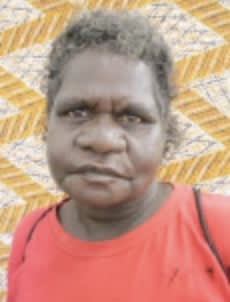Raelene Kerinauia Liddy Lampuwatu Australian, Tiwi, b. 1962
Raelene was born on Bathurst Island and raised by her grandmother. Her older brother Vivian is also a painter. Raelene began designing screens for fabric printing in 1985 as a part of the adult education programme in Milikapiti and then started to paint when the new arts centre (Jilamara Arts and Crafts Centre) was established in 1989. Initially she used brushes with ochres but since 1999 has used the traditional painting techniques of using comb - kayimwagakini. Combs were used for ceremonial body painting application and are typically made from bloodwood or ironwood. Raelene was inspired to use the traditional technique of kayimwagakini after watching young and emerging artist PedrovWonaeamirri, and viewing older pole carvings in the National Museum (Canberra) by the late Tiwi carver Sugarbag Kapiti. The making of the comb is a skill into itself, and Raelene's late husband James Tipiloura, a carver with Jilamara Arts, carved the combs for Raelene's work. "I paint with the kayimwagakini or comb, sometimes it is called pwoja, which also means bone. The painting comb is made from ironwood, part of the tree, and is used to paint on the body, on pukumani poles and on bark. My partner made me my comb, he was an artist, a great carver and I used to paint his carvings and tutini (pukumani poles). He passed away not long ago. I use ochres from the Tiwi Islands for my painting and I mainly just use my comb. Only sometimes do I use brush. This is how I feel like painting. I started the comb in the nineties. Well, I'd decided to paint with the colmb. I use one colour at a time." The compositions Raelene creates are personal creative expressions, without literal meanings, but they do relate to body painting and designs for pukumani poles. It is not an inherited design. It's imagination but it's not new. Raelene's compositions are thought out while the canvas is blank, she looks and thinks of her design and by the time she has painted the base colour she already knows where her other colours will be placed to create the final effect. "Paint the background and then think about it. Each comb is different. I paint the red comb line first, then red (angle), leave it, gap, red, red, red."
